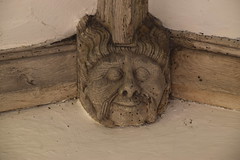| |
|
Follow these journeys as they happen at Last Of England
Twitter.
A big church in a large, curiously remote
village. Metfield, with its pub and community village
stop staffed by volunteers, is far enough from anywhere
of any size to feel like it has a life of its own, and in
the 19th Century this was even more the case. At the time
of the 1841 census, when the populations of most rural
East Anglian parishes were beginning to reach their peak,
this village had more than 700 residents, and could boast
a surgeon, a schoolmaster, a tailor, a bricklayer, an inn
and two beerhouses, three shoemakers, two butchers and
three grocers. White's 1844 Directory of Suffolk
notes that Mrs Susan Godbold has resided in the parish
for eighty years, and in 1843 she walked round the
village on her 104th birthday. A century later, Arthur
Mee found her grave while poking around in the
churchyard, and noted that she had died at the remarkable
age of 105.
However, the church seems to have been in a fairly
moribund state by the early years of the 19th Century. By
one of those arcane pieces of Church legislation, the
church was what was known as a donative, which is to say
that there were no presentation to the living or
rectorial income, and the institution of a minister was
in the hands of the congregation, who paid him a salary
as a chaplain. This was all well and good, and sounds
very democratic, but it relied on a large number of
parishioners attending church and paying for the
privilege of doing so. By the 19th Century, the level of
Anglican churchgoing in East Anglia had fallen to about
an eighth of the population (it was slightly higher than
this in Metfield) and consequently there simply wasn't
enough money to maintain a minister and the upkeep of the
buildings. Thomas Mayhew, the Rector of Rumburgh St
Michael, who served as chaplain at the time of the 1851
Census of Religious Worship, complained that some
parishioners who have not signed the agreement have
refused to pay their portion of composition which cannot
be recovered without action at law... in the course of
time this church will be robbed of its only money
payment.
In some parts of Suffolk, the independent churches were
more popular than the Established church, but this seems
not to have been the case at Metfield, where the
Methodist Society had only about a dozen members. It
seems that in Metfield, as in a lot of north-east
Suffolk, most people simply didn't go to church any more.
A series of reform acts, and the revival of the Church of
England in the second half of the 19th Century, would
have a dramatic effect on parishes like Metfield. And
yet, the restoration of the church was a light one. The
large, aisleless church sits in its tight churchyard,
18th and 19th Century headstones huddling against it. The
view from the west is typical, with no great statements,
no flowery Victorian windows, just a fine, tall tower
lifting to a simple bell window and the battlements and
pinnacles restored in the 18th century. Apart from these,
the building is pretty much as it was on the eve of the
Reformation.
The 15th Century porch is typical of the way in which
rural East Anglian parishes tried to emulate the grandeur
of near-neighbours with more money. Here, the porch is
vaulted, but in wood, probably by a local carpenter, and
there are even bosses as if we were in the porch of Eye
or Wymondham. These are also wooden, several depicting
heads. One is a green man, another had swallows' nests
tucked in above to give him a full head of hair on one
occasion that I visited. The central boss is bigger than
the rest. It's a bit battered, and is said to depict
Christ in Majesty, although it appears to me that he is
holding the remains of a cross, in which case he is
probably a rare wooden depiction of the Holy Trinity, God
the Father holding the crucified Son as the dove of the
Holy Spirit descends, these last two members of the
Trinity now lost.

  
You step into a nave which is light and
open, the furnishings attractive. There's a pretty west
gallery put up in the 18th Century, and below it are
surviving panels from the medieval rood screen, still
with their original paint. When Peter Dickinson was
revising the Little Guide to Suffolk in the
1950s he found these still in situ within the chancel
arch, but the chancel has since been simply reordered, as
full of light as the nave.
The great treasure of Metfield church is set in the roof
above the east end of the nave. This is the 15th Century
canopy of honour, a decorative boarded ceilure. It was
designed to surmount the rood, the crucified Christ
flanked by the Blessed Virgin and St John, but this would
have been destroyed by the Anglican reformers in the
middle of the 16th Century. On the large bossed panels
are roundels containing the monograms IHC and AMR
surrounded by vines leaves and bunches of grapes rendered
in red and green. If you look carefully at the south side
you'll see that one of the middle bosses has a grinning
face with its tongue out. It was probably intended as a
lion or some other animal, but it has become known as the
Metfield imp.
Anyone who has visited this church will recall the slow,
steady ticking of the early 17th century clock. You can
see the mechanism through the gates in the tower arch. It
was already more than two hundred years old when Sarah
Godbold did her birthday walk around the streets of
Metfield.
Simon Knott, April 2019
Follow these journeys as they happen at Last Of England
Twitter.
|
|
|

